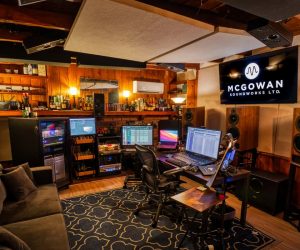
How the Decca Tree Grew
In 1984, Mike Gray helped assemble a discography of Decca’s classical releases, giving him access to their engineers and recording logs, and a valuable insight into how their records were made. He reveals the truth about the famous Decca tree and the creation of the label’s unique sound.
By: Mike Gray
Interview: Tom Flint
It’s not well known, but there were at least seven or eight different tree formations with a variety of microphone types and there were two philosophies of using a tree. One was the Roy Wallace philosophy, the tree by itself, which produced a wonderful three-dimensional image; the second came from Kenneth Wilkinson who decided that the tree needed help from outriggers. Eventually their techniques blended – Wallace was using outriggers, as were other technicians.
The original trees back in ’54 and ’55 used Neumann M50s with a variety of baffles. The microphones were positioned close together so the baffles were to isolate the mics, thereby avoiding spillage. Also the M50 was omnidirectional so the fear was losing that precise centre image. They later discovered that it wasn’t necessary to baffle or have the microphones close together.
In the early ‘60s they had shoot outs. They would take an open Neumann KM56 tree and a baffled M50 tree and record portions of sessions with each. All the engineers would listen together and a consensus developed. Wilkinson was involved in lots of experiments in London using different KM56 trees, trying out several trees in a session.
In the 1960s they still sometimes used a tree with three baffled M50s closely spaced, but by about ‘64 they finally settled on the standard tree that has mics about two feet apart, left to right, and another about one-and-a-half feet out in front, plus outriggers. Later on, many spot microphones, echo returns and a lot of other techniques were used to create the Decca sound.
When recording, the producer was focussed on the artist, so the engineer, or his tape op, was responsible for the tree and outriggers. There was a rule of thumb but they adjusted things by ear to get that sound on tape. They made diagrams on the ‘Electrical Record of Session’ so if they ran over they could replicate the setup in terms of mic height and placement.
Sometimes it was as simple as a tree and outriggers, but it depended on the music and the hall. Kingsway Hall was rather dingy, but had a great sound because of its domed ceiling. Walthamstow is basically a box so you got a different sound there. In latter days Decca had acoustic signatures of all their halls and understood their frequency characteristics, but originally Arthur Haddy or Wilkinson would just walk in, clap their hands and say, ‘This sounds good, let’s use this!’
The key to understanding the difference between Decca and EMI is that Decca always wanted to mix to two tracks, although they had four-track backups in case they needed to track in a singer or rebalance. EMI went to four-track in the mid ‘60s and their records weren’t produced at the session like Decca’s.
But the Decca sound was really the sound of the microphones. The M50 was omnidirectional and designed for German radio with a boost at the top. That was a famous Decca trait from the age of 78s, although it was tamed a bit when the discs were cut. Later they mainly used KM56s and KM53s because they were small enough to put on stands in the back but eventually they started using bigger Neumann U67s, U88s and a whole variety of spot microphones. There would often be spots behind the horn section, percussion, and on the woodwind — that also became a Decca trademark.
Everything was tweaked by the backroom guys. They might replace a microphone’s tube with a MOS-FET, or some of the resistors to flatten it out, but the key point is that none of the equipment was stock. There was always something done to make it better – make it Decca. That was the genius of Decca: the people doing the mixing were telling the maintenance guys what they needed.
Roy Wallace built many of the Decca portable mixers, such as the Storm 64, which had the ability to mix 24 microphones into two tracks and was used all over the world. You didn’t go to Neve in those days — you built your own.
But the gear was nothing unless you had operators who knew how to use it. It’s inaccurate to say it was flat at the board because they made adjustments depending on the piece of music and where they could put the microphone. If you look at the Electrical Records of Session you see all kinds of fixes on the way to tape.
They didn’t use compression but there was a lot of gain riding. The idea was that a loud movement would peak at zero, but the soft movements also had to come close to match. We’re not talking about ferocious gain riding, just little tweaks. But it was done very subtly and a good operator would never reveal what they had done in the sound.
There were also compromises at the disc cutting stage, which was another key factor in the Decca sound. To make a stereo disc you had to cut the bass and blend it below 100Hz so that the vertical motion would not be too extreme for styli tracking. And they would cut at half speed in the early days to get the maximum number of watts.
























RESPONSES